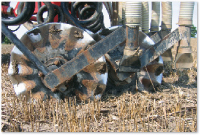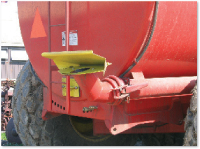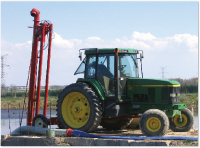
Features
Applications
Other
Mixing manure with no-till a tricky practise
July 11, 2008 by Ralph Pearce
The notion of applying manure in a
no-till situation might cause some growers to ask ‘Why?’ For innovative
types, the question becomes ‘Why not?’ provided there are some caveats
or considerations in place.
The notion of applying manure in a no-till situation might cause some growers to ask ‘Why?’ For innovative types, the question becomes ‘Why not?’ provided there are some caveats or considerations in place.
 |
| Martin VanRaay used a 12.5 foot wide injector toolbar with 7.5 inch spacings. |
With prices for nitrogen-based fertilizer and other inputs continuing to spiral upwards, the need to maximize manure value from available sources is also increasing. Furthermore is the realization that those on the farm are being watched, not just by environmental authorities but by neighbours and consumers.
At a recent gathering of innovative farmers in Ontario, Canada, a panel discussion on the merits of manure in no-till highlighted the efforts of three producers. Each discussed his own unique operation, including manure types, crop rotations and equipment, always stressing the need for increased diligence in combining manure applications with no-till management systems.
Cornelissen Farm
George Cornelissen has a 1600 acre operation near Watford, Ontario. He grows corn, soybeans, wheat, alfalfa and edible beans, with a combination
of manure from 60,000 broilers, liquid manure from neighboring hog finishing and isolation barns, and pack manure from another neighbor’s 400 cow
dairy operation.
Cornelissen’s has a lot of experience in manure management, particularly working and modifying the various equipment models he has used for spreading on his operation. With a reliance on so much broiler manure, Cornelissen concedes it spreads like a powder depending on the bedding being used and the dry matter content. Speed across the field and spots where concentrations were spread heavier posed additional challenges, including millipede damage to planted seed. “But the most challenging thing of all is where to set the nitrogen,” says Cornelissen.
Configurations on the manure spreader, depending on the design, could leave a producer having to apply more than 100 pounds of nitrogen, in spite of any manure applied to the soil. As a result, he began working with different brand names, gauging the response from various types of manure as well as some of the modifications. Using a Meyer spreader for instance, he found it worked better with higher moisture manure but not with broiler manure, which effectively burned emerged soybeans. Using a Bergman spreader however, he modified the square plates on the bottom to allow the petals to interlock a little better than with the circular plates, and found it helped break up larger particles for more even distribution.
 |
| The toolbar is also equipped with two inch wavy coulters. |
 |
| In 2006, Martin VanRaay experimented with a tanker equipped with a 40 foot splash plate. With a goal of applying 10,000 gallons of manure per acre, he applied 5000 gallons preplant and 5000 gallons post. |
 |
| In 1994, VanRaay built a two million gallon earthen manure storage unit to accommodate his expanded hog operation. |
VanRaay Farm
Farming as he does in proximity to Lake Huron, Martin VanRaay stresses the need to properly manage manure in a no-till system. The Dashwood, Ontario, area producer works a 500 sow farrow-to-finish operation, with 650 acres of high moisture corn used for feed, plus soybeans and wheat.
VanRaay cited the variable soil types in his fields – including sandier parts among tough clay hills – as the primary reason for no-tilling on his operation. Labour, with one person working the field and two people in the barn, was another consideration.
VanRaay has worked with many tankers and spray applicators and irrigation units over the years. From 1974 to 1986, he used a 2000 gallon Husky tanker with small tires and splash plates, adding fertilizer to the fields as needed. In 1986, he began using irrigation pipes to move some of his manure. In 1997, he incorporated a narrow row tanker with 11.5 inch wheels to accommodate his 20 inch row spacings.
During the same time period, the farm expansions began. In 1982, VanRaay grew to a 180 sow farrow-to-finish operation while managing his crops conventionally. He began experimenting with no-till eight years after that. In 1994, he expanded the hog operation to 500 sows, then further expanded his land base and built a 3500 pig finishing barn a year later. He also built a two million gallon earthen storage unit in 1995.
From 1997 to 2003, VanRaay eliminated the use of phosphorous and potassium, and reduced his 28 percent side dress applications from 100 pounds to 75, and then from 50 pounds to zero. Starting in 2002, he began side dressing manure between his crop rows. Starting in 2004, he applied 50 percent of his manure application preplant and the remainder post, resulting in a trend toward earlier manure application.
In 2005, VanRaay decided to use drag hoses to apply his operation’s two million gallons of manure and found many pros and cons. Labour was a pro since he used custom workers to apply the manure. However that also delayed planting on some fields. “But we did plant our soybeans while they were putting the manure on that year,” says VanRaay. “And most of my land is near my manure so the drag hose did work.”
On the con side was the cost. At $22,500, VanRaay thought it was an expensive lesson, and the custom applicator missed some of the corners and headlands. There was also one million gallons of manure that still needed to be side dressed later.
In 2006, VanRaay decided to experiment with other modes of manure application. That season, he used a tanker equipped with a 40 foot splash plate. With a goal of applying 10,000 gallons of manure per acre, he applied 5000 gallons preplant and 5000 gallons as a post. In fields near his operation, he was able to apply 50,000 gallons of manure per hour. For off-farm sites, that rate dropped to 25,000 gallons of manure per hour. While this resulted in less hours needed to move the manure, there were still problems, including tracks left in the wheat field.
In 2007, VanRaay moved to a 10,000 gallon injector, 12.5 feet wide with 7.5 inch spacings. He also opted for a single manure application at a rate of 10,000 gallons of manure per acre, injected in to the soil four inches and applied at a speed of about six to eight miles per hour. “At that rate and depth, no manure was visible after application,” he says.
“On the plus side, manure application was much timelier with this system,” VanRaay says, adding that the injection system helped to provide some pre-tillage, making planting a bit easier. On the minus side, the depth of the injectors was variable and there were issues with some of his farm’s clay soils being compacted.
Eisses Farm
Not afraid of new ideas, Kevin Eisses utilizes various methods for maximizing no-till cropping, while experimenting with manure applications as well as composting on the family farm. He is a second generation producer from Innisfil, located near Barrie, Ontario, with 110 dairy cows at one site and heifers at another farm. As for land base, he has more than 2000 acres planted to corn, soybeans and alfalfa, as well as some sunflowers and canola.
The liquid manure he applies is collected from the 110 dairy cows and supplemented with pack manure from the heifers and dry cows located about a mile away. Eisses also takes liquid manure from his uncle’s 40,000 layer operation. Like VanRaay’s farm, Eisses faces the challenge of farming in close proximity to Lake Simcoe and dealing with residents along the lakeshore.
Working with no-till and managing manure have been a focus for Eisses since the late 1980s when his family first attempted no-till wheat using a John Shearer hoe drill. “We wanted to sow winter wheat after hay because the hay ground is travelled over quite often during the year,” explains Eisses, adding it made no sense to plow up the hay field and then level it with a disc or cultivator.
They switched to a Great Plains planter a few years later, first, to help cut through the tougher hay residue and second, to further the no-till management to soybeans. By 1995, they had added a Kinze corn planter for no-till corn.
In 2007, Eisses purchased a Salford Residue Tillage Specialist (RTS) unit to address volatilization and odor issues during manure application. He was uncertain whether it helped to run the Salford unit before or after applying manure, yet he acknowledged the coulters on the unit did a better job of cutting residue and working a shallow depth of soil. “So far, we’re satisfied with the job of incorporation the Salford does,” says Eisses, conceding there have been some problems penetrating wheat stubble.
With the farm’s dry manure, Eisses has turned to composting, adding a
Sittler compost windrow turner. Two sources of dry manure are used, each with varying concentrations of bedding, and blended into a windrow in the field using a modified haylage truck. They run the turner once daily the first week, every-other-day the second and every third day by the third week.
Keeping the temperature at a constant 140 degrees F is a challenge, but one that yields an actual market from nearby residents. “It’s very satisfying to take something that is treated as a waste product and make it into something desirable that people actually drive into your farm and say they want,” Eisses says.